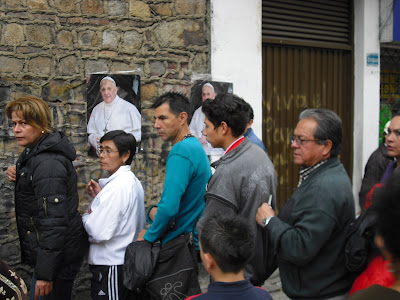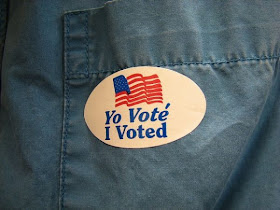These are, it seems, especially exciting times to be Latino. Once seen as one of the poor relations of the globe – apart from producing world-class soccer players (or footballers if you will) and some pretty tasty lady models – Latino land is making itself and its people heard on other fronts of late.
The most obvious and celebrated of these has been the election of Argentina’s Jorge Mario Bergoglio, or now known simply as Pope Francis, as leader of the Roman Catholic Church.
 |
| Pope Francis — bigger than Jesus. |
Not only is he the first Latino to take up this position – it’s not important that Argentina is seen by many as the most European country in this part of the world – but he’s the first from all of the Americas as well as the first from the Southern Hemisphere.
Now, as momentous an occasion as it has been made out to be, perhaps we shouldn’t be too surprised considering that South America is home to what’s believed to be almost 300 million Catholics, making it the most Rome-led region on the planet (how that actually manifests itself is something different as we’ve documented before – see http://bit.ly/13VtSAZ).
Now, as momentous an occasion as it has been made out to be, perhaps we shouldn’t be too surprised considering that South America is home to what’s believed to be almost 300 million Catholics, making it the most Rome-led region on the planet (how that actually manifests itself is something different as we’ve documented before – see http://bit.ly/13VtSAZ).
When you take that into account, it makes sense that there should be a South American native holding the top job at the Vatican – although, you’re right, sense and the Catholic Church don’t always go hand in hand.
As outwardly important that religion appears to be for many Latinos, perhaps the biggest and most significant rise of this varied group of people can be seen to the north of their homeland – North America to be precise.
As was the case for the Irish Catholic immigrants in the same part of the world up until the early part of the last century, the Latinos/Hispanics in North America, more specifically the USA,* have been looked upon with suspicion and mistrust from the United State’s founding fathers, the WASPs and,** ironically enough, many Irish and Jewish Americans who are now very much part of the country’s fabric.
The discrimination towards them might not have been as obvious as it was to other groups in previous eras, but it certainly has existed.
That, though, is rapidly changing. The similarities with the Irish Americans’ transition from social outcasts to big players in the political and economic worlds are apparent.
By sheer force of numbers alone the Hispanic vote is something the traditional power holders in the States can no longer ignore – they are due to be the largest voting bloc come the next US presidential election in 2016.
As outwardly important that religion appears to be for many Latinos, perhaps the biggest and most significant rise of this varied group of people can be seen to the north of their homeland – North America to be precise.
As was the case for the Irish Catholic immigrants in the same part of the world up until the early part of the last century, the Latinos/Hispanics in North America, more specifically the USA,* have been looked upon with suspicion and mistrust from the United State’s founding fathers, the WASPs and,** ironically enough, many Irish and Jewish Americans who are now very much part of the country’s fabric.
The discrimination towards them might not have been as obvious as it was to other groups in previous eras, but it certainly has existed.
That, though, is rapidly changing. The similarities with the Irish Americans’ transition from social outcasts to big players in the political and economic worlds are apparent.
 |
| Crucial vote. (Picture from ivn.us) |
That’s just counting the documented or ‘legals’ – should some sort of a solution for the undocumented/‘illegals’ be found during President Obama’s final tenure, the numbers of Latino-origin residents in the country would rise considerably. It’s widely accepted that they make up the bulk of the estimated 11 million undocumented in the USA.
As much as we like to think differently, the politicians, or at least their advisers, aren’t stupid. Many US immigrants vote Democrat, so if the Obama administration can fix the undocumented problem, this should ensure that trend is enhanced for some time to come.
Even the traditionally inward-looking Republicans are doing their bit to find favour among the Hispanics.
As much as we like to think differently, the politicians, or at least their advisers, aren’t stupid. Many US immigrants vote Democrat, so if the Obama administration can fix the undocumented problem, this should ensure that trend is enhanced for some time to come.
Even the traditionally inward-looking Republicans are doing their bit to find favour among the Hispanics.
The party’s official response to Obama’s State of the Union address earlier this year was given by the Cuban American Florida senator Marco Rubio, with his speech in both English and Spanish. Indeed, Rubio is tipped by many to be a future presidential candidate for the Republicans. A Republican Latino version of JFK perhaps?
It’s not, however, just the power of numbers that have aided the Latino/Hispanic rise. They’ve also shown themselves to be more than capable of mixing it with the best that the US has to offer.
It’s not, however, just the power of numbers that have aided the Latino/Hispanic rise. They’ve also shown themselves to be more than capable of mixing it with the best that the US has to offer.
The typical image of the Spanish speaking cleaner or nanny or general labourer isn’t fitting the narrative as easy as before. No, they’re becoming high-rollers. Again, like the Irish Americans, through hard work and perseverance they are becoming more and more accepted into US society.
The WASPs et al. fears that Hispanics would dilute the vibrant, strong work-ethic culture that made the USA the self-proclaimed greatest country on the planet are being unfounded.
In fact, from a Colombian American perspective – as we alluded to in ‘Colombia’s dissenters’ (see http://bit.ly/13X1AXb) – many of these immigrants adapt to the prevailing culture pretty well and actually thrive in it.
The WASPs et al. fears that Hispanics would dilute the vibrant, strong work-ethic culture that made the USA the self-proclaimed greatest country on the planet are being unfounded.
 |
| Pitbull — also bigger than Jesus it seems. (Image from Pitbull's website.) |
Yes, they bring their own Latino colour just as the Irish have ‘greened’ up the place, especially around St Patrick’s Day, but they also bring an appetite for work and success – qualities the first European settlers in North America prided themselves on.
So while the Latino stock is rising outside of their original homeland, what about things inside? Being such a diverse land with many different countries, it’s not something that can be easily summed up.
So while the Latino stock is rising outside of their original homeland, what about things inside? Being such a diverse land with many different countries, it’s not something that can be easily summed up.
However, while many from the Western world may be flocking to the place to escape the ‘misery’ of their lives in the rat-race, a large number of ambitious Latinos still look to leave their homeland to ‘better’ themselves.
In similarity again with the Irish, a good number of Latinos still believe they have a better chance of realising their potential outside of their birthplace. That may be steadily changing, though.
_________________________
*For a more detailed account of the terms 'Latino' and 'Hispanic', see http://en.wikipedia.org/wiki/Hispanic_and_Latino_Americans
**WASPs - 'White Anglo-Saxon Protestants' for any of you who were wondering.
In similarity again with the Irish, a good number of Latinos still believe they have a better chance of realising their potential outside of their birthplace. That may be steadily changing, though.
_________________________
*For a more detailed account of the terms 'Latino' and 'Hispanic', see http://en.wikipedia.org/wiki/Hispanic_and_Latino_Americans
**WASPs - 'White Anglo-Saxon Protestants' for any of you who were wondering.
No comments:
Post a Comment